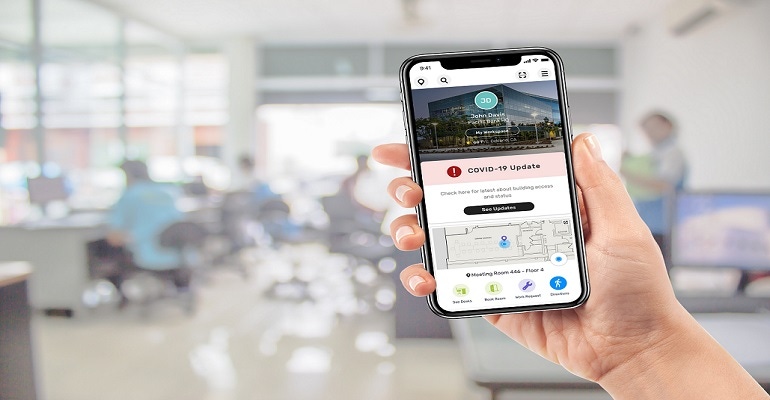Siemens has developed a system design to guide companies through the process of reopening the workplace during the pandemic.
November 10, 2020

Siemens is deploying a workplace experience solution that is designed to enable over 600 company locations to return to work safely. The experience application, Comfy, lays the foundation for agile and future-oriented working. Siemens acquired the Oakland-based company a couple of years ago. Comfy combines location, usage, and smart building data with a wide range of user demands that connect and coordinate employees in their work environment.
Comfy is now getting deployed to help companies adhere to health regulations. The tool includes:
Location-specific COVID-19 updates and health regulations
Digital maps fueled by employee-based data to optimize workplace navigation
Workstation reservation capabilities
The option to deploy a network of IoT sensors to enable real-time data solicitation

We spoke with Brad Haeberle, VP of service and solutions at Siemens Smart Infrastructure, to find out the way Comfy is enabling the return to the workplace during the pandemic.
DN: How do workstation reservation capabilities support a safer return to the office?
Brad Haeberle: As provided via Comfy, workstation reservations enable employees to view and book desks and office spaces, allowing them to make better, more informed decisions – ultimately restoring trust and confidence in office spaces.
Comfy’s digital booking feature enables building managers to ensure that physical distancing guidelines and regulations are being adhered to and met while providing real-time data on what desks and offices have been used and require sanitization; those desks and offices are temporarily taken “offline” until cleaning has been completed. Through the Comfy app, employees can also locate the PPE equipment nearest to their workspace and submit requests for desks to be sanitized or equipment to be repaired.
DN: How does the solution account for hybrid work-from-home and safe-work-environment models?
Brad Haeberle: Comfy supports organizations both with safely returning employees to the workplace and in transitioning to new, flexible working models for the future of work.
The employee-facing mobile app empowers employees to find and book the right spaces for their productivity and collaboration needs (activity-based working) and to find colleagues with whom they need to collaborate. Comfy’s app also acts as a central communications hub that businesses can use to keep employees informed of the latest, locally-relevant information about their workplaces, including changing guidelines and office protocols, which helps to boost employee confidence and trust in returning to the workplace.
For organizations, data insights from multiple sources enable building managers to right-size real estate portfolios. By better understanding how employees are using spaces, they can be better designed to support new working models. Comfy supports businesses in developing healthy, safe spaces for employees. A mobile-first experience reduces the amount of high-touch surfaces in the workplace, connecting employees to the services and amenities they need.
DN: Do users have the option to deploy a network of IoT sensors to enable real-time data solicitation?
Brad Haeberle: When integrated with a sensor network, such as the sensor suite from Enlighted, a Siemens company, Comfy’s platform gives valuable data insights into how spaces are being used. This enables real estate managers to make informed decisions regarding real estate strategy, both during the return-to-work phase and into the future.
For example, managers can gain insights into high-traffic areas, most frequently booked desks and office spaces to monitor real-time occupancy levels. These data insights are key to intelligently right-sizing real estate portfolios for cost savings and optimization and to ensure office spaces can be designed to meet the needs of the future of work.
DN: How do location-specific COVID-19 updates work to help prepare the work environment?
Brad Haeberle: Companies generally have regional teams closely monitoring local health guidelines and adapting policies appropriately and the Enlighted technology was designed to be adaptable to changing needs.
For example, with the Enlighted Safe application/workplace digital contact tracing, you can define contacts by one, two, five, fifteen, or thirty-minute increments, as well as by distance (“close,” “near” and “far”) in an easy pull-down menu. We provide both duration and total duration of an exposure, which is incredibly useful given the CDC’s recently changed guideline that defines a contact-violation as contact between two individuals closer than six feet for a 15-minute cumulative total over a 24-hour period. Both are already covered in the Safe application.
Companies can use local health guidelines for their definition of a contact-violation, and select the appropriate options, or decide to be more or less conservative.
Rob Spiegel has covered automation and control for 19 years, 17 of them for Design News. Other topics he has covered include supply chain technology, alternative energy, and cybersecurity. For 10 years, he was the owner and publisher of the food magazine Chile Pepper.
About the Author(s)
You May Also Like





